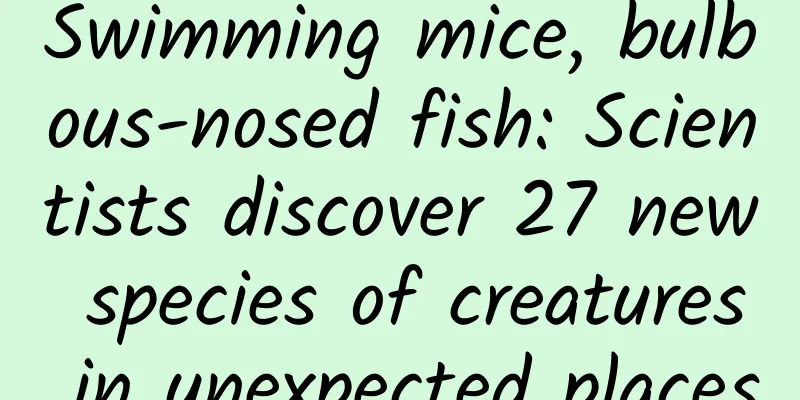Swimming mice, bulbous-nosed fish: Scientists discover 27 new species of creatures in unexpected places

|
Located in northern Peru, between the Amazon rainforest and the Andes Mountains, Alto Mayo is a mosaic of diverse ecosystems that is one of the most biodiverse regions in South America. However, urban and agricultural expansion are threatening the local environment . Perhaps it’s assumed that biodiversity won’t be high near humans, so most ecological studies have focused on the forest reserves northwest of Alto Mayo. To break this imbalance, in the summer of 2022, Conservation International launched the Rapid Assessment Project to collect biological information specifically in the central region where human activities are intensive. A piece of land that has been deforested in a forest reserve Not long ago, the project report came out, and people were surprised to find that this piece of land, which had always been unpopular among biologists, was actually far more vibrant than they had imagined. Trond Larsen, leader of the "Rapid Assessment Project", said that he discovered that this place was unusual almost at the beginning of the project. Larsen and his team were traveling in the foothills when a frog suddenly came into view. The frog had black skin and a protruding nose, and when it jumped, its bright pink belly revealed, which immediately made him recognize it as the extremely rare Upper Amazon short-legged frog. Upper Amazon short-legged frog (Atelopus seminiferus) | Source: Herp Italia Larsen was shocked not only because of the frog’s rarity, but also because it appeared so close to humans at such a low altitude—just before it appeared, a donkey cart carrying fresh wood had passed by. The frog was also a good omen, opening the curtain for subsequent discoveries. During the 38-day search, researchers recorded more than 2,000 species of plants and animals in central Alto Mayo, including 49 endangered species and 27 new species discovered for the first time . Of all the new species, a swimming mouse is the most exciting for researchers, as amphibious rodents are very rare in South America. This mouse is all black with some webbed feet and lives near a swamp full of palm trees. The land where it was found was severely damaged by agricultural expansion, but fortunately it has been planned as an ecological restoration forest. Mammals are one of the categories that humans know best. This project discovered four new mammal species, including the "amphibious mouse", which is of great significance. | Source: ConservationInternational A strange fish has also attracted the interest of scientists. This catfish looks similar to most of its peers, but there is a huge water droplet-shaped structure in front of its eyes , which looks like a "garlic nose" at first glance. Some scholars speculate that this special structure may be used to detect prey hidden deep in the riverbed, but its true function needs further study. Catfish with a "bulky nose" | Source: Conservation International Larsen's team also found many dung beetles. Dung beetles, commonly known as "dung beetles", not only purify the environment by eating mammal feces, but also fertilize the soil, spread seeds, and control the spread of pests by burying feces. Generally speaking, the presence of dung beetles means that the local ecological environment is good , but in this project, they also appeared widely in forests with obvious signs of deforestation and even in coffee plantations. The report shows that the "Rapid Assessment Project" recorded a total of more than 70 species of dung beetles in central Alto Mayo, of which 2 were new species. Peruvian green dung beetle (Oxyster nonconspicillatum) | Source: Conservation International Other species discovered for the first time include: an eel that can live on land for a long time and can freely shuttle between different waters; a salamander with oversized eyes and a slender body that lives in the woods on the white sand beach; a butterfly with translucent wings and unique patterns... This salamander lives in low vegetation and has a fried-like texture to its skin | Conservation International The report points out that Alto Mayo's new findings prove that land affected by human activities can still maintain high biodiversity and should not be ignored by conservationists. On the contrary, considering that so many species are still surviving under human expansion, protecting habitats has become more urgent. "One of the reasons I was so surprised by the results of the exploration is that there is basically a 'blank' there, and no one has taken these lands seriously," Willy Palomino, an ecologist at Conservation International, told the media. "We still need to answer some questions from this trip, such as why many organisms in the original forest appear in the secondary forest." Morning mist shrouds the forest in Alto Mayo | Photo credit: Trond Larsen In the 1990s, people in the Alto Mayo region rented out their land to immigrants to build forests, farmlands and plantations for their livelihoods, resulting in large-scale destruction of the forest. Today, local people and the government have realized the importance of protecting the ecology, and one of the prerequisites for effectively protecting local nature is to first know who lives here. This report provides profound insights into local land management. In the future, local governments and environmental organizations will rationally plan which lands to designate as new protected areas, which lands to restore the ecology of, and within what ranges reasonable agriculture, logging, and ecotourism will be allowed. Perhaps in the future, people will discover more new species in Alto Mayo. References [1]https://www.conservation.org/stories/new-discoveries-in-a-changing-landscape-uncovering-alto-mayos-hidden-biodiversity [2]https://www.conservation.org/blog/i-almost-couldnt-believe-it-amazon-expedition-stuns-researchers [3]https://www.nytimes.com/2024/12/20/science/peru-alto-mayo-species-discovered.html Planning and production Source: Bring Science Home (ID: steamforkids) Author: Liu Liuqi Editor: He Tong Proofread by Xu Lai and Lin Lin |
>>: Feeling dizzy and having pain in the neck? Don't ignore it, it may not be cervical spondylosis
Recommend
Game planner’s analysis: Why is Honor of Kings so addictive?
Why do college girls have trouble sleeping every ...
The price of experimental monkeys has soared 20 times! Why is it so hard to find a monkey now?
The price of experimental monkeys has risen from ...
Don’t know how to increase your conversion rate? Let’s play games!
There is a very interesting thing recently. There...
The protagonist of global warming is melting, do you really understand it?
When it comes to glaciers, perhaps the only thing...
Humanity's Asteroid-Earth Rescue Plan
Under the coastline of Mexico's Yucatan Penin...
Are electric toothbrushes a waste of money?
Recently, I saw a netizen saying that he has to h...
How to promote and operate Xiaohongshu? Xiaohongshu promotion tips!
Not long ago, the news about Xiaohongshu conducti...
Xueersi Online School’s system of mentoring new students
Xueersi Online School is an online education bran...
WeChat Moments ads cannot be closed and are named. Official response: Strengthen ad review
On December 16, the Shanghai Consumer Council rel...
Does eating sweet potatoes make you fat or lose weight? What is the difference between sweet potatoes and purple potatoes? Finally it's clear
How many people can resist the fragrant sweet pot...
After chatting with a group of marketing directors, some understandings about leading a team
After working for three to five years, most of my...
So sweet! Science paper confirms that "love existed before the Christian era"
"My love for you was written in BC and burie...
“Jump Jump” is popular, how can brands leverage this momentum for marketing?
The WeChat mini -game “Jump Jump” has become very...
Nobel Prize Dinner Cancelled Will the 2020 Nobel Prize Ceremony be Cancelled?
Nobel Prize dinner cancelled According to the CCT...









